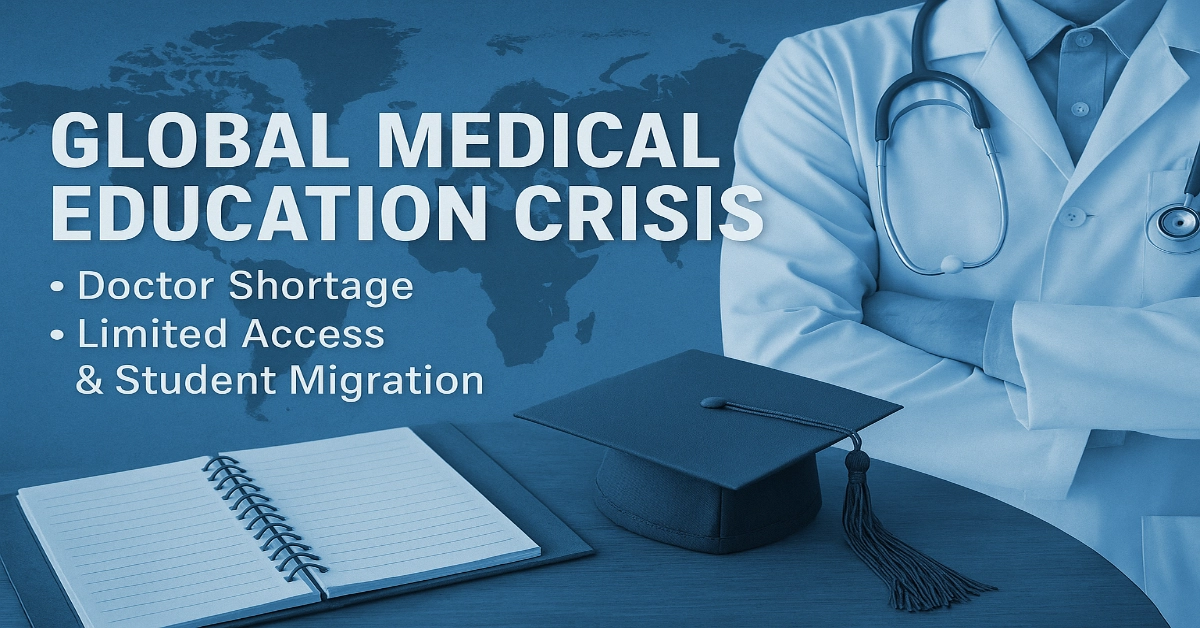Global Medical Education Crisis: The global healthcare system is facing a serious crisis. Despite shortages of doctors, many countries are failing to expand access to medical education. This has resulted in international student mobility.
While earlier medical education across borders was smooth, it is now increasingly nationalised yet globally pursued, especially by students from the Global South.
Global Demand in Cross-Border Medical Education
With the rising demand for healthcare professionals, a growing number of students are looking for foreign universities to pursue medical education.
- Though exact figures vary, estimates suggest over 200,000 international students are studying medicine outside their home countries.
- Many opt for institutions in countries with lower academic barriers and easy admission processes, though these sometimes come with questionable standards.
Before the 2022 Russia-Ukraine conflict, Ukraine alone hosted approximately 24,000 international medical students, most of them from India, Morocco, Nigeria, and other developing nations.
India: A Case Study of Crisis and Contradiction
India exemplifies the global crisis in medical education with a stark contrast between the demand for doctors and limited access to medical seats.
- 2.3 million+ NEET UG aspirants in 2024 alone.
- Fewer than 1 in 21 students get admission into the ~780 medical colleges in India.
- 20,000+ Indian students go abroad annually for MBBS education due to restricted seats and unaffordable fees at private institutions.
Popular MBBS Abroad Destinations:
- Russia, Georgia, Kazakhstan, Kyrgyzstan, Nepal, and Mauritius.
In response to domestic competition and cost barriers, Indian students are increasingly enrolling in foreign institutions, often choosing countries where English-medium programs are available and entrance exams are minimal or non-existent.
Indian Influence Abroad: Exporting Medical Education
Interestingly, India is not just exporting students; it’s exporting institutions.
- The Manipal College of Medical Sciences (MCOMS), Nepal, was established by the Manipal Education and Medical Group (MEMG), Bengaluru.
- American University of Antigua (AUA) in the Caribbean is another institution operated under the Manipal umbrella.
These institutions provide alternative options for Indian students while also building India’s educational presence on a global stage.
Licensing and Quality Recognition
Despite finding access abroad, students returning to India face a major challenge: licensure.
- Graduates must clear the Foreign Medical Graduate Examination (FMGE) to practice in India.
- Licensing exams in other countries (like the USMLE, PLAB, AMC) are also mandatory for those seeking to work abroad.
This emphasises the lack of standardisation across medical curricula and underlines serious concerns around the quality of foreign medical education.
Addressing India’s Doctor Shortage
In the Union Budget 2025, Finance Minister Nirmala Sitharaman acknowledged the challenges in medical education and committed to expanding capacity.
Budget Highlights:
- A 130% increase in medical UG and PG seats over the past 10 years.
- Addition of nearly 10,000 new MBBS seats in 2025.
- A long-term plan to create 75,000 medical seats under a new five-year initiative.
While this is a step in the right direction, experts argue that further reforms are needed to address geographic disparities, faculty shortages, and regulatory inefficiencies.
Global Trends in Europe and the West
This crisis is not isolated to India or developing countries. Even students from Western Europe and the United States are heading abroad due to restricted access to medical education at home.
Trends in the West:
- Students from Germany, the Netherlands, and France are pursuing medical degrees in Hungary, Georgia, Bulgaria, and Poland.
- Many of these countries now offer English-medium MBBS programs tailored to international students, often charging premium tuition fees.
- In the United States, some students choose Caribbean medical schools to circumvent intense competition and high costs at home.
These programs, while accessible, are often lightly regulated, and many operate as for-profit institutions, prioritising revenue over academic rigour.
Risks of the Current Situation and Status-quo
The commodification of medical education poses significant risks to both students and healthcare systems.
Major Concerns:
- Inconsistent education quality across institutions
- Inadequate clinical exposure or faculty
- Lack of standard international benchmarks
- Regulatory loopholes and a lack of transparency
Without a globally enforceable accreditation standard, the disparity in doctor training may impact patient safety, research integrity, and healthcare delivery.
The rise in international mobility for medical education reflects a deepening crisis in both supply and structure. While student mobility offers hope, it also highlights the urgent need for global reforms in healthcare education.
Recommendations:
- Establish a global accreditation framework for medical institutions.
- Improve capacity, affordability, and transparency in domestic medical education systems.
- Create regional partnerships to standardise licensing and practice rights.
- Strengthen oversight of for-profit foreign medical universities.
The medical education crisis is not just about numbers; it’s about future doctors, global health equity, and the sustainability of healthcare systems.


